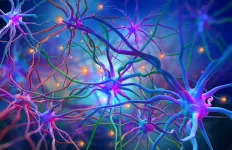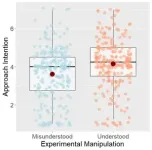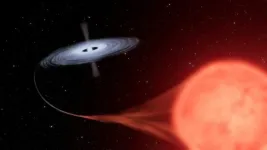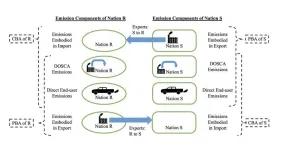(Press-News.org) The genetic disease Huntington’s not only affects nerve cells in the brain but also has widespread effects on microscopic blood vessels according to research.
These changes to the vasculature were also observed in the pre-symptomatic stages of the disease, demonstrating the potential for this research for predicting brain health and evaluating the beneficial effects of lifestyle changes or treatments.
Huntington’s disease is an inherited genetic condition leading to dementia, with a progressive decline in a person’s movement, memory, and cognition. There is currently no cure.
The study, published in Brain Communications, is by Juliane Bjerkan, Gemma Lancaster, Peter McClintock and Aneta Stefanovska from Lancaster University, Jan Kobal, Sanja Šešok and Bernard Meglič from the University Medical Centre in Ljubljana, Karol Budohoski from the Cambridge University Hospitals NHS Trust, and Peter Kirkpatrick from Cambridge University.
The team investigated changes in the coordination between neuronal activity and the brain’s oxygenation in Huntington’s disease.
The vasculature and brain work together to ensure that the brain receives sufficient energy. In fact, the brain needs as much as 20% of the body’s energy consumption despite only weighing approximately 2% of the body’s weight.
The “neurovascular unit” consists of vasculature connected via brain cells called astrocytes to neurons and ensures that this cooperation is successful.
To assess the function of these neurovascular units, the researchers combined non-invasive measurement techniques and novel analysis methods developed by Lancaster’s Nonlinear and Biomedical Physics group.
Probes emitting infrared light were placed on the heads of participants in the study. The infrared light penetrated the skull harmlessly and enabled researchers to measure the brain’s blood oxygenation.
Electrodes, which can measure electrical activity from neurons, were also placed on the heads of participants. The researchers then studied the many rhythms related to the functioning of the brain and the cardiovascular system using mathematical techniques. These rhythms included the heart and respiration rates, related to the transport of nutrients and oxygen, as well as slower rhythms associated with local control of blood flow. Brain activity manifests in faster rhythms.
Efficient functioning of the brain depends on how well all these rhythms are orchestrated. To assess the efficiency of the neurovascular unit, both the strength and the coordination of these rhythms were assessed by computing their “power” and “phase coherence”.
Professor Aneta Stefanovska of Lancaster University said: “We are hopeful that the method described could be used to monitor the disease progression and to evaluate the effect of potential treatments or lifestyle changes in Huntington’s disease and other neurodegenerative diseases. We also hope that our study will stimulate new treatments of Huntington’s disease targeting the vasculature and brain metabolism.”
END
How the brain is affected by Huntington’s Disease
2024-06-11
ELSE PRESS RELEASES FROM THIS DATE:
MOLLER experiment baselined and moving forward
2024-06-11
NEWPORT NEWS – The U.S. Department of Energy’s Thomas Jefferson National Accelerator Facility is moving forward on a project to gain new insight into the interactions of electrons. The MOLLER experiment will make an extremely precise measurement of the electron’s force field to learn about specific and rare interactions with other subatomic particles. On May 28, the experiment received approvals of both Critical Decision 2 and Critical Decision 3 from the DOE.
The MOLLER research program was established at Jefferson Lab as a DOE Major Item of Equipment (MIE) project to build the equipment required to support the experiment.
These ...
Engaging with patients for better treatments and outcomes for smell and taste disorders
2024-06-11
PHILADELPHIA (June 10, 2024) – Researchers and patient advocates from the Monell Chemical Senses Center, Smell and Taste Association of North America (STANA), and Thomas Jefferson University came together during the COVID-19 pandemic to incorporate patient voices in efforts to prioritize research areas focused on improving care for people with smell and taste disorders.
To this end, in 2022 these collaborators conducted a survey and listening sessions with patients, caregivers, and family members affected by impaired smell or taste. They asked about their individual perceptions of the effectiveness of treatments, among other topics. Using an online questionnaire, ...
Study shows first evidence of sex differences in how pain can be produced
2024-06-10
Research suggests that males and females differ in their experience of pain, but up until now, no one knew why. In a recent study published in BRAIN, University of Arizona Health Sciences researchers became the first to identify functional sex differences in nociceptors, the specialized nerve cells that produce pain.
The findings support the implementation of a precision medicine-based approach that considers patient sex as fundamental to the choice of treatment for managing pain.
“Conceptually, this paper is a big advance in our ...
Hubble finds surprises around a star that erupted 40 years ago
2024-06-10
Astronomers have used new data from NASA's Hubble Space Telescope and the retired SOFIA (Stratospheric Observatory for Infrared Astronomy) as well as archival data from other missions to revisit one of the strangest binary star systems in our galaxy – 40 years after it burst onto the scene as a bright and long-lived nova. A nova is a star that suddenly increases its brightness tremendously and then fades away to its former obscurity, usually in a few months or years.
Between April and September 1975, the binary system HM Sagittae (HM Sge) grew 250 times brighter. Even more unusual, it did not rapidly fade away as novae commonly do, but has ...
NASA’s Webb opens new window on supernova science
2024-06-10
Peering deeply into the cosmos, NASA’s James Webb Space Telescope is giving scientists their first detailed glimpse of supernovae from a time when our universe was just a small fraction of its current age. A team using Webb data has identified 10 times more supernovae in the early universe than were previously known. A few of the newfound exploding stars are the most distant examples of their type, including those used to measure the universe's expansion rate.
"Webb is a supernova ...
May research news from the Ecological Society of America
2024-06-10
The Ecological Society of America (ESA) presents a roundup of four research articles recently published across its six esteemed journals. Widely recognized for fostering innovation and advancing ecological knowledge, ESA’s journals consistently feature illuminating and impactful studies. This compilation of papers explores how wolf reintroduction affects other carnivores, how drought and grazing snails together drive salt marsh productivity, the key to an invasive fish’s success and the plight of backyard trees, ...
Taking the fall: How stunt performers struggle with reporting head trauma
2024-06-10
In the heart-pounding action scenes of your favorite blockbuster, it's not always the A-list actor taking the risks but the unsung heroes—stunt performers—who bring those breathtaking moments to life. However, behind the glamour lies a grim reality: the reluctance of these daredevils to report head trauma, fearing it could jeopardize their careers.
In the recently released blockbuster, “The Fall Guy,” audiences get a behind-the-scenes look at what stunt professionals go through to create those most thrilling moments, and although this film celebrates these skilled professionals, it does not highlight the impact the stunts can have on their health.
Ohio ...
Income inequality and carbon dioxide emissions have a complex relationship
2024-06-10
Income inequality and carbon dioxide emissions for high-income nations such as the United States, Denmark and Canada are intrinsically linked – but a new study from Drexel University has taken a deeper look at the connection and found this relationship is less fixed, can change over time, and differ across emission components. The findings could help countries set a course toward reducing emissions of the harmful greenhouse gas and alleviating domestic income inequality at the same time.
The ...
Yuan elevated to IEEE senior member
2024-06-10
Jinghui Yuan, an R&D staff member in the Applied Research for Mobility Systems group at the Department of Energy’s Oak Ridge National Laboratory, has been elevated to a senior member of the Institute of Electrical and Electronics Engineers, or IEEE.
Senior member status is the highest grade of IEEE and requires extensive experience that reflects professional accomplishments. Only 10% of IEEE’s more than 450,000 members achieve this level.
As a transportation engineer in the Buildings and Transportation Science Division, Yuan’s research focuses on intelligent transportation systems, crash risk prediction, big data analytics, deep learning, traffic simulation and ...
Passive heat exposure increases stress on the heart, posing risk to adults with history of CAD
2024-06-10
Embargoed for release until 5:00 p.m. ET on Monday 10 June 2024
Annals of Internal Medicine Tip Sheet
@Annalsofim
Below please find summaries of new articles that will be published in the next issue of Annals of Internal Medicine. The summaries are not intended to substitute for the full articles as a source of information. This information is under strict embargo and by taking it into possession, media representatives are committing to the terms of the embargo not only on their own behalf, but also on behalf of the organization they represent.
----------------------------
1. ...







